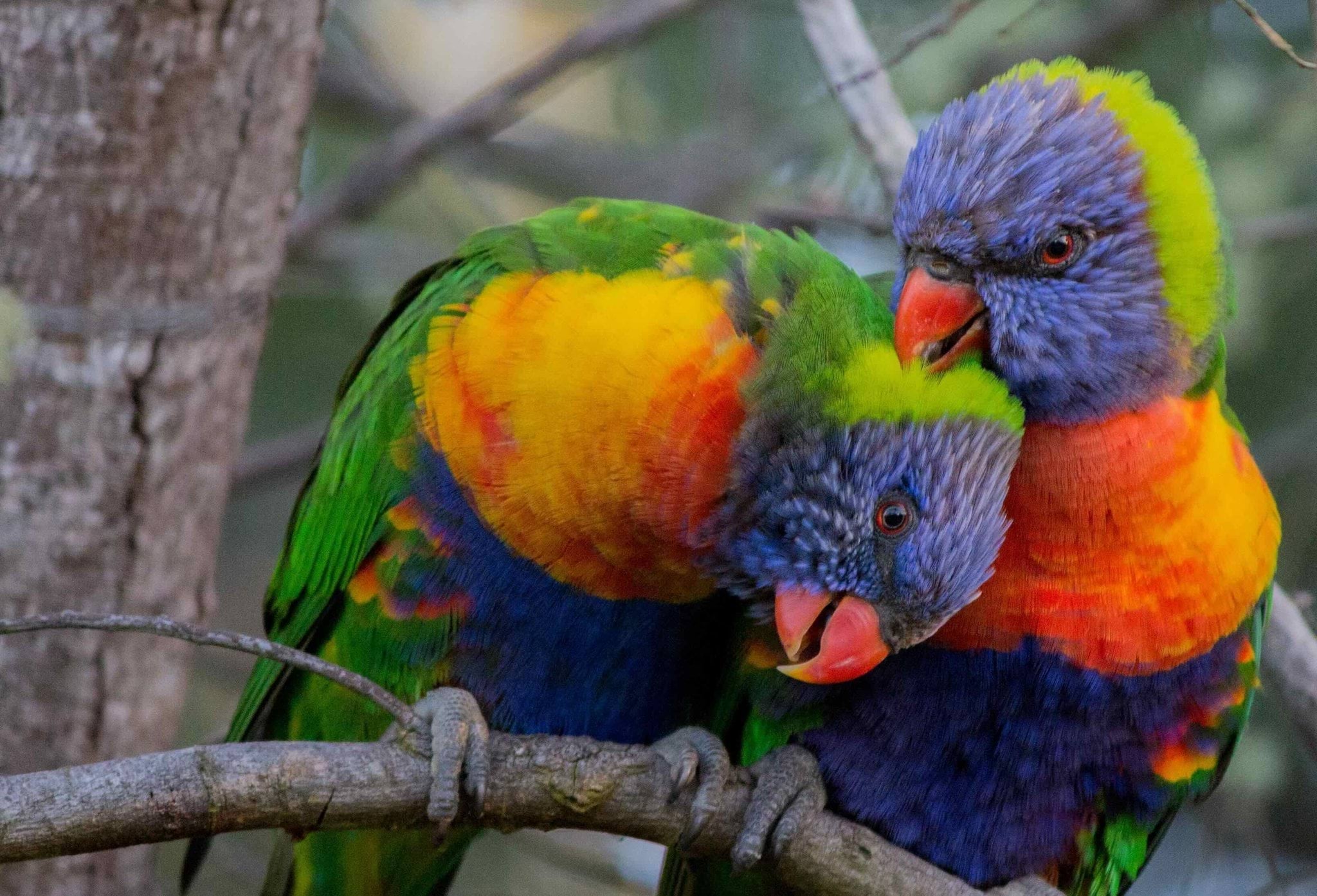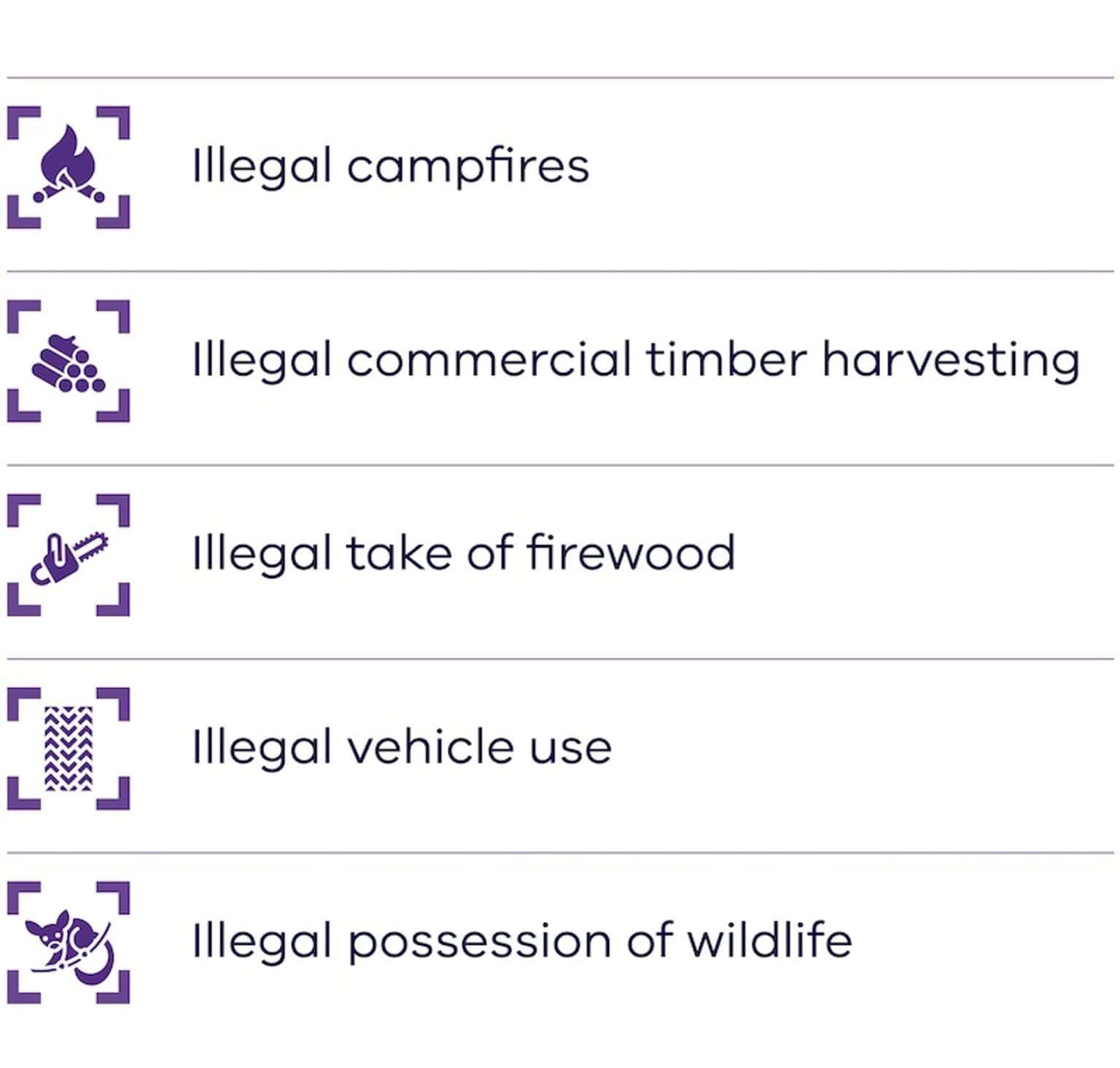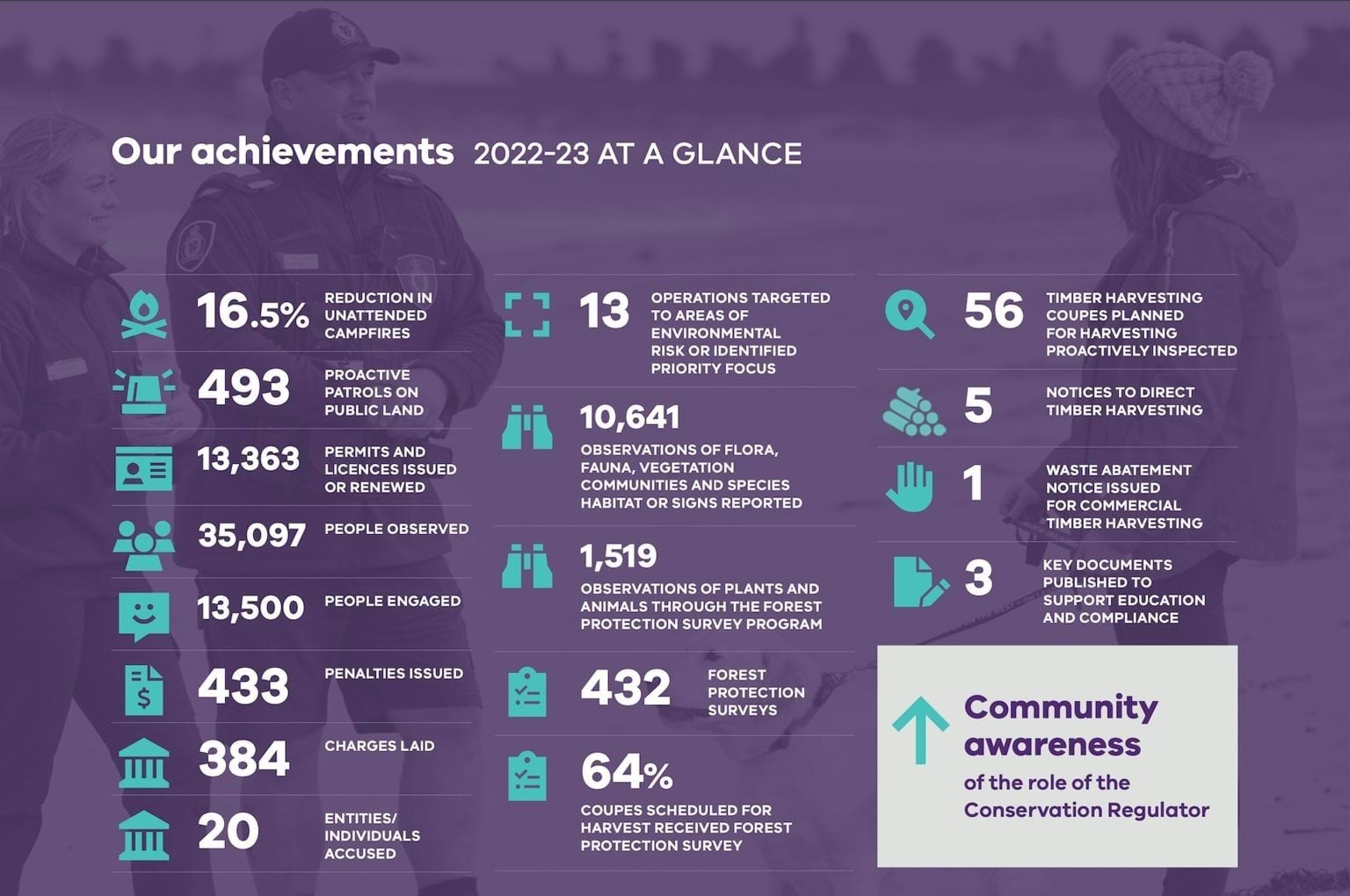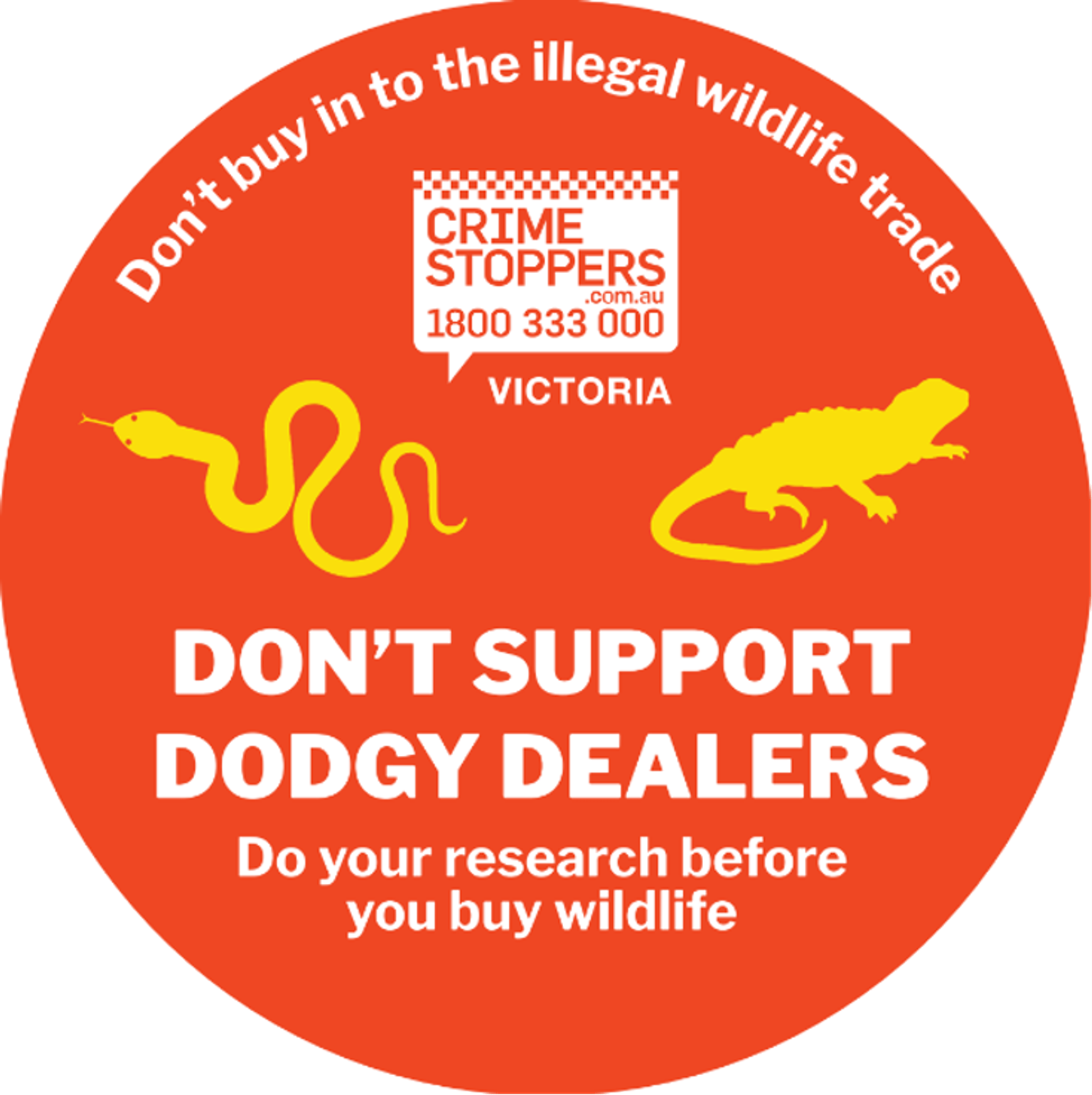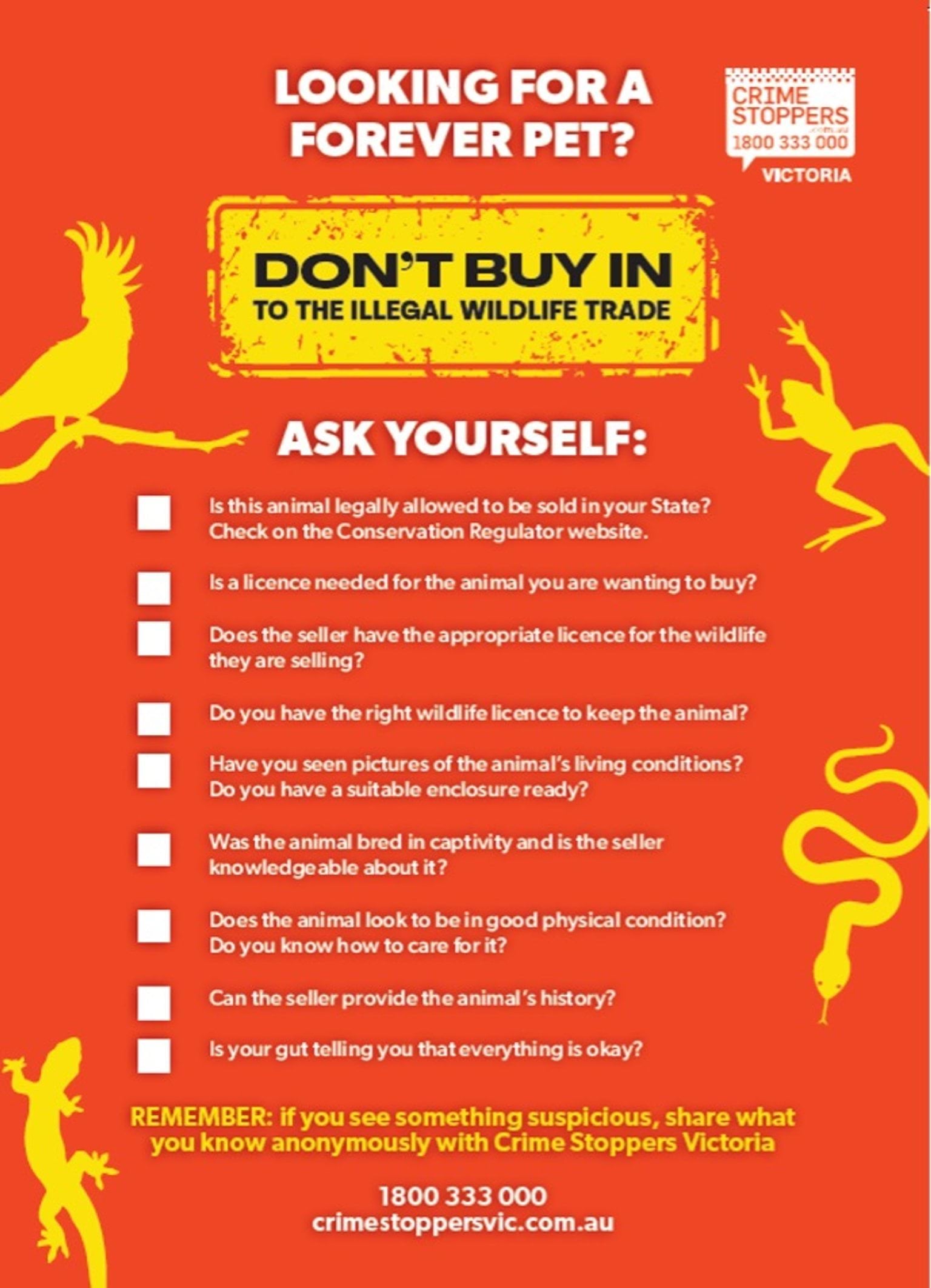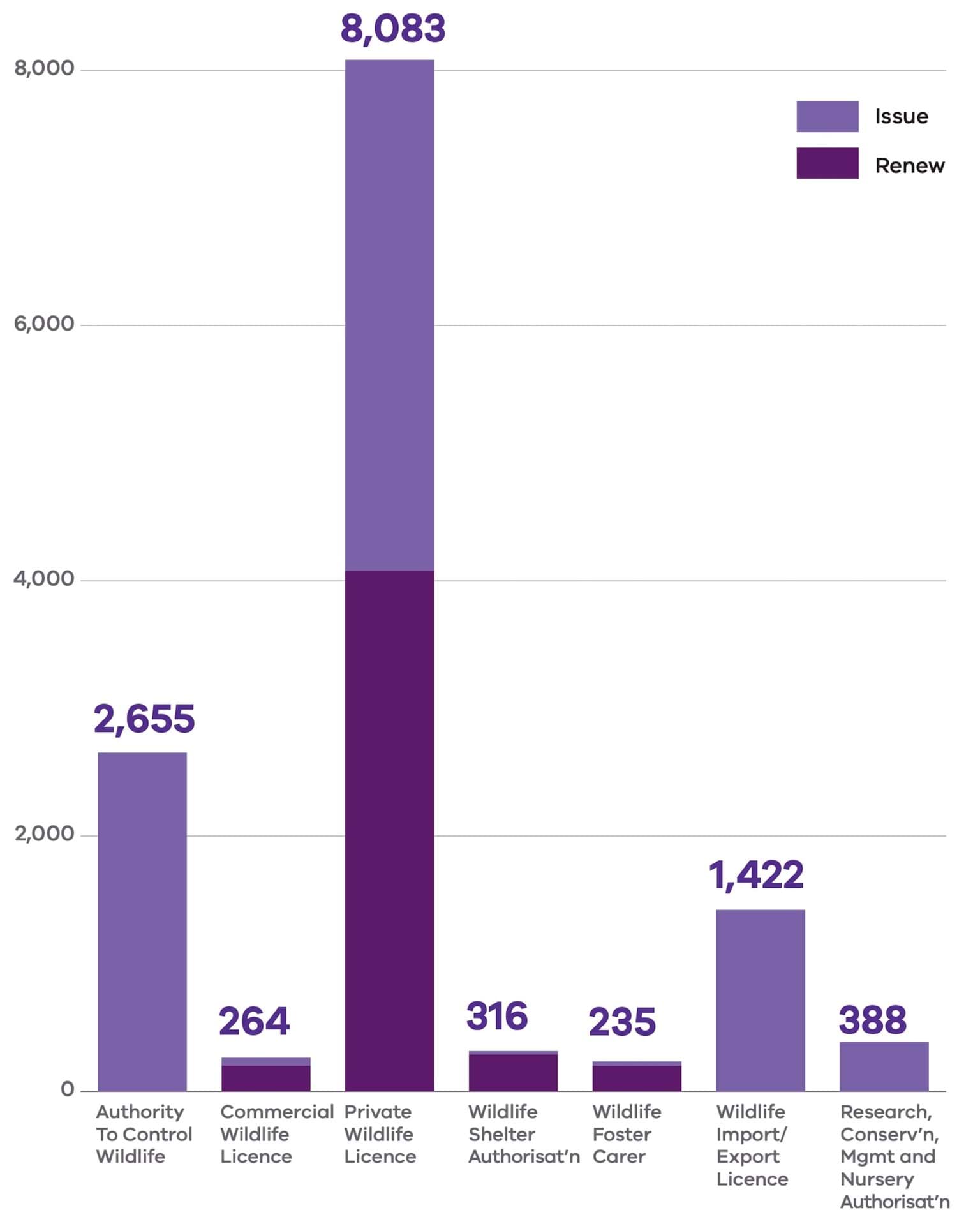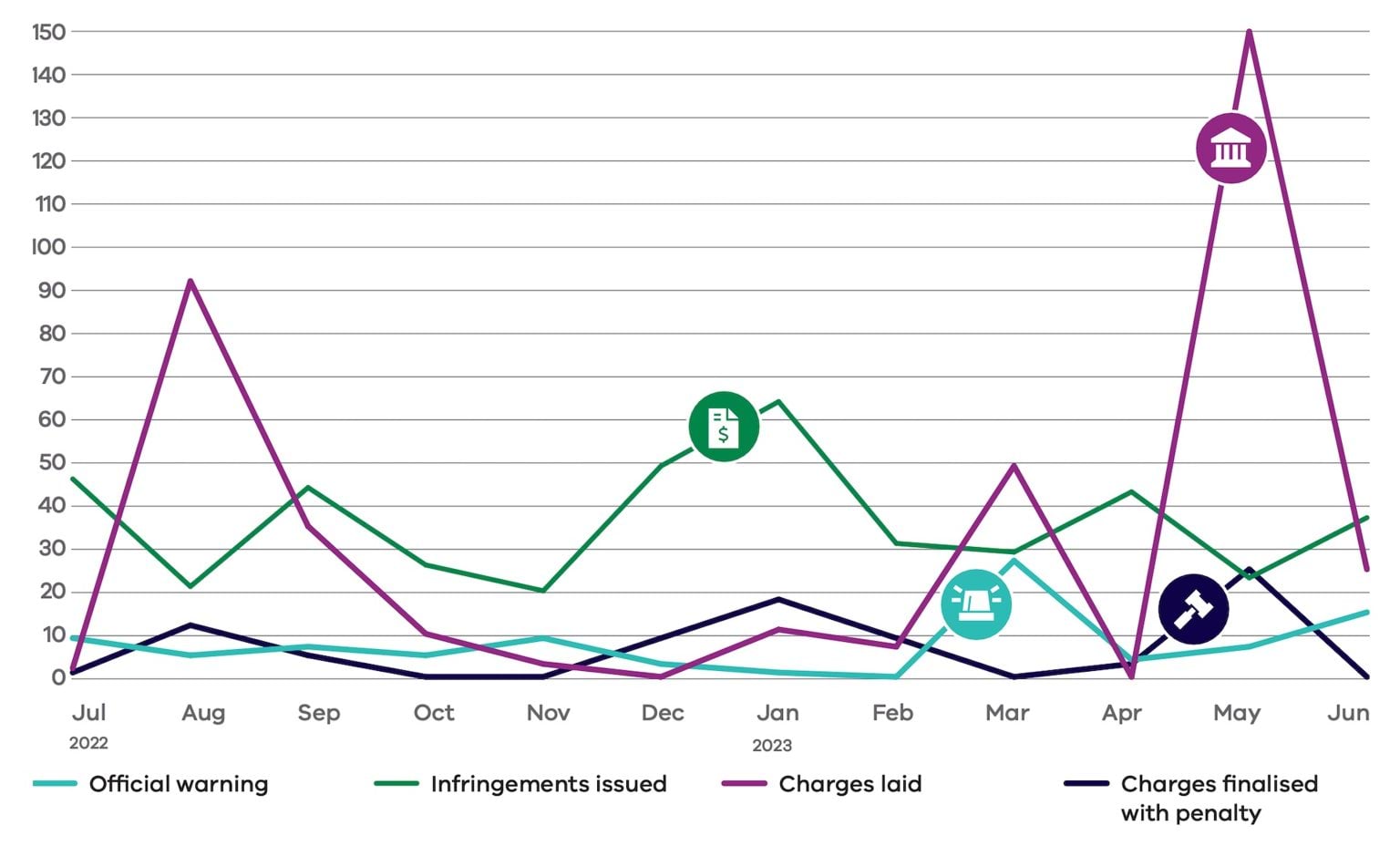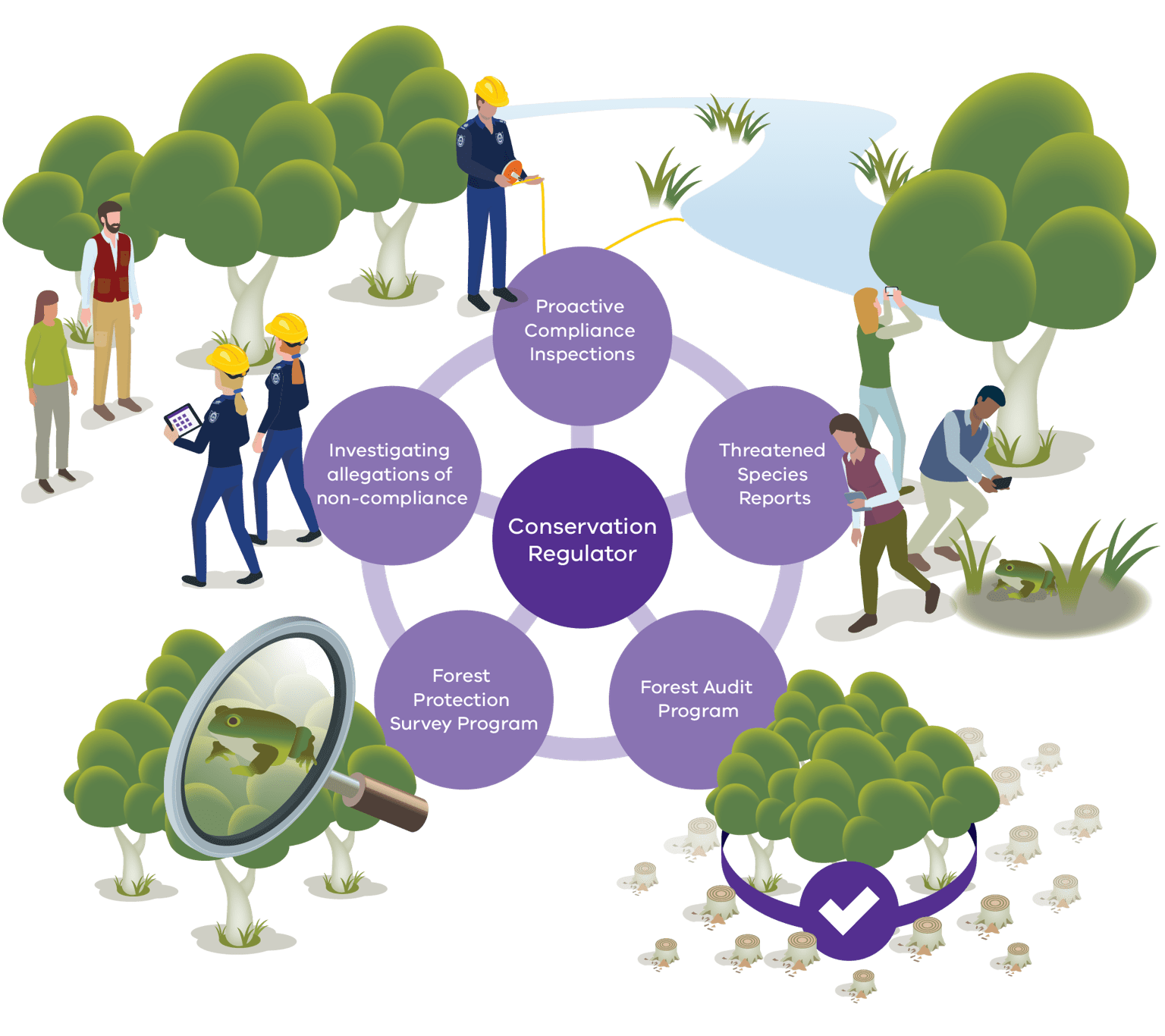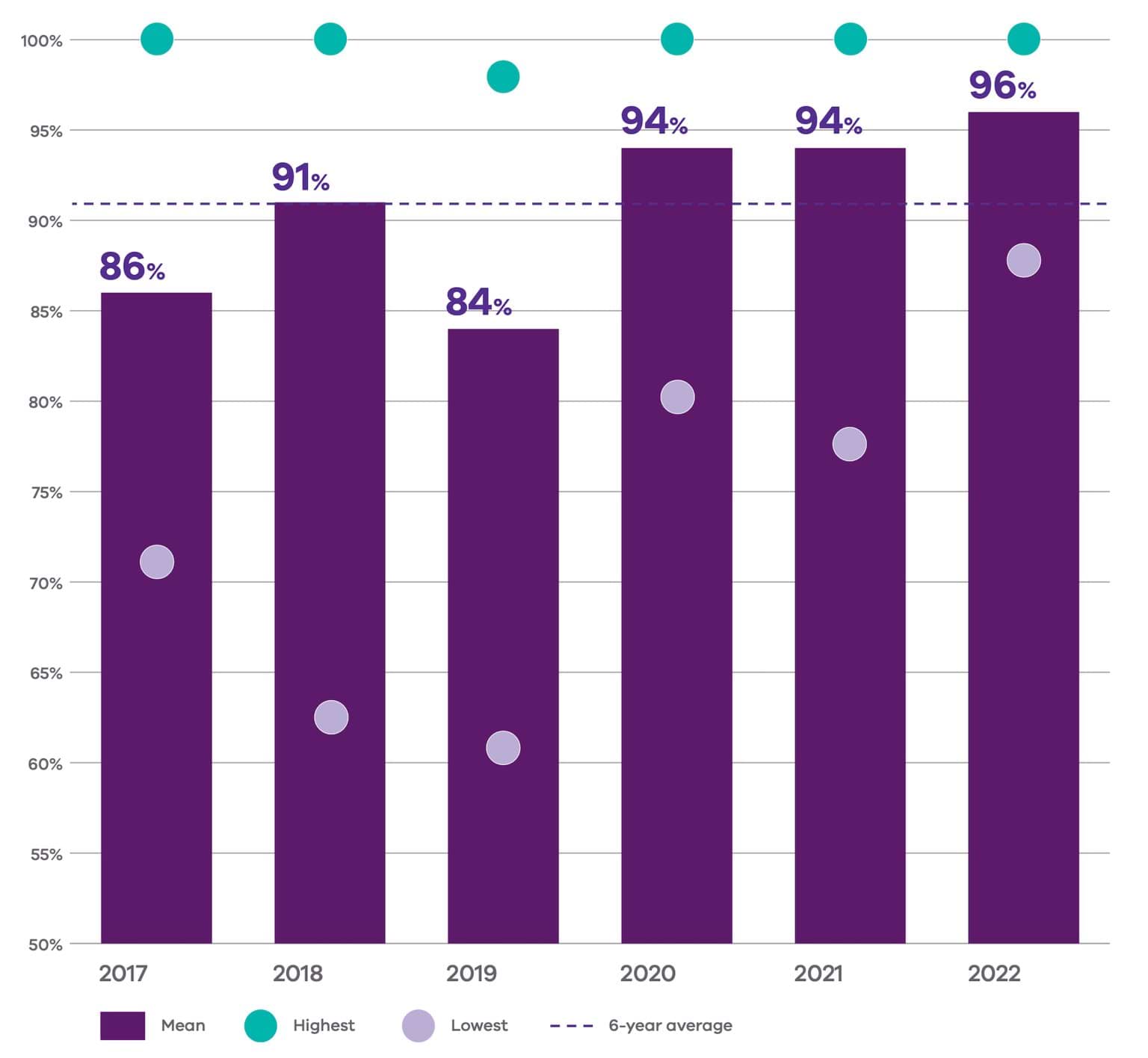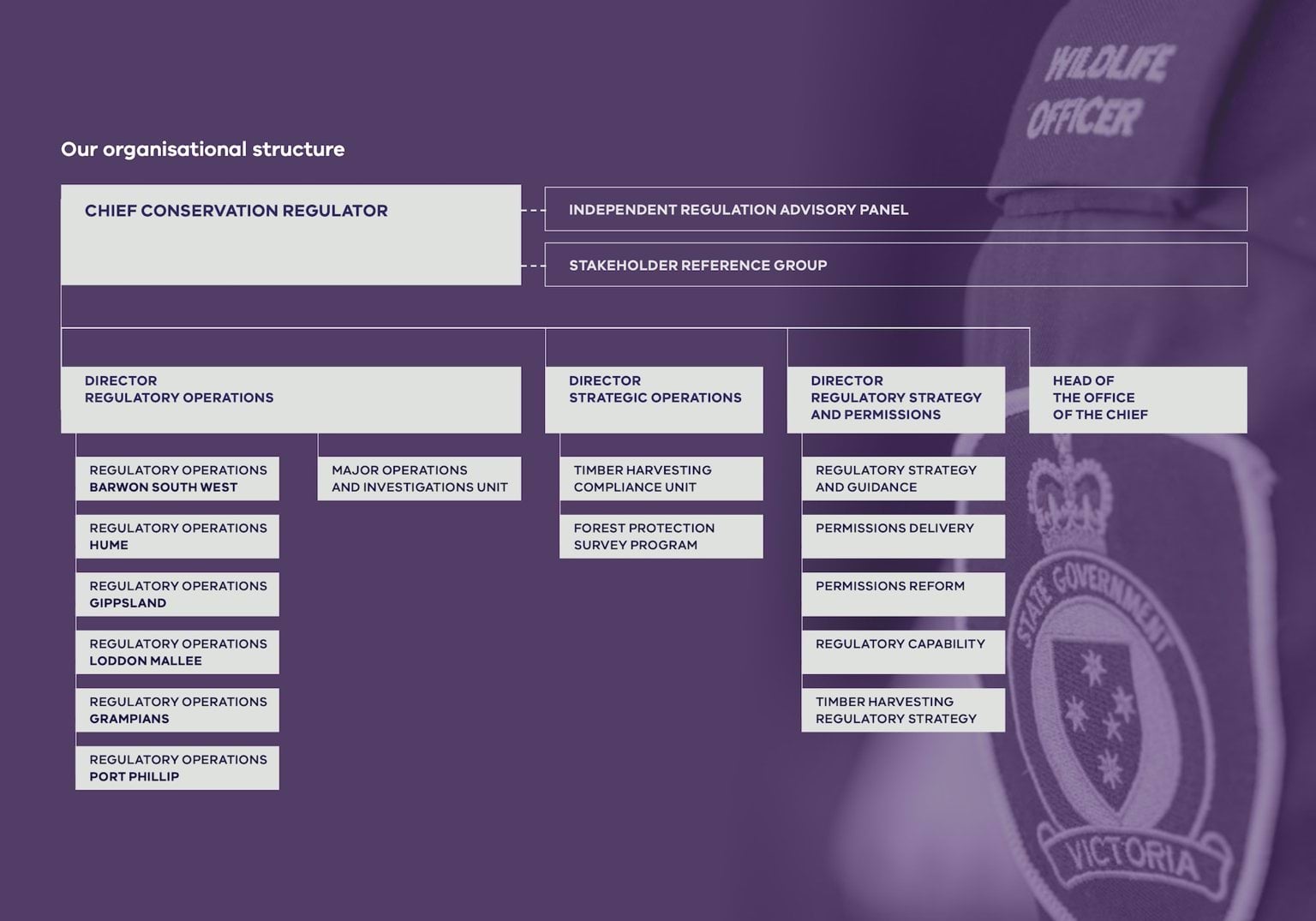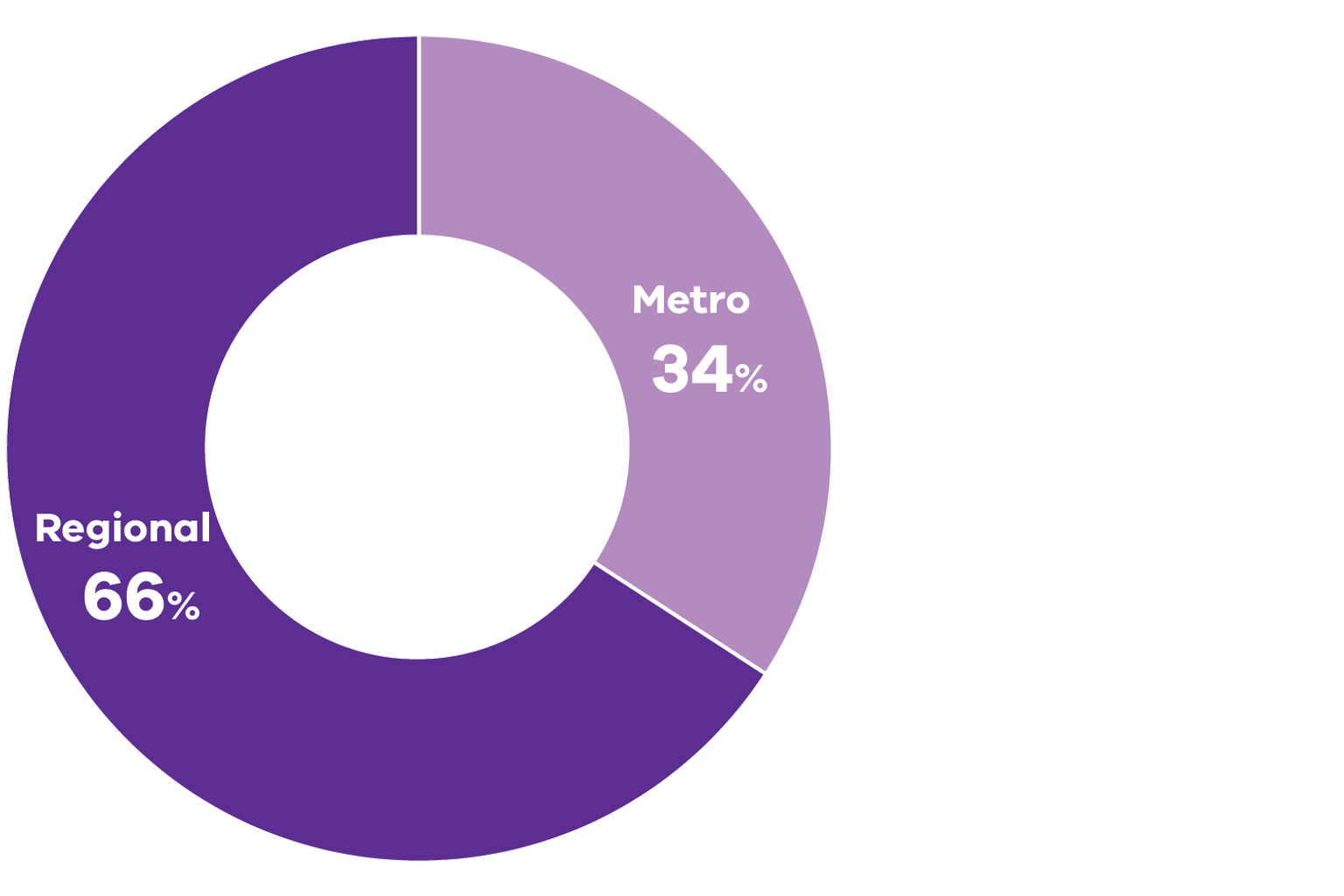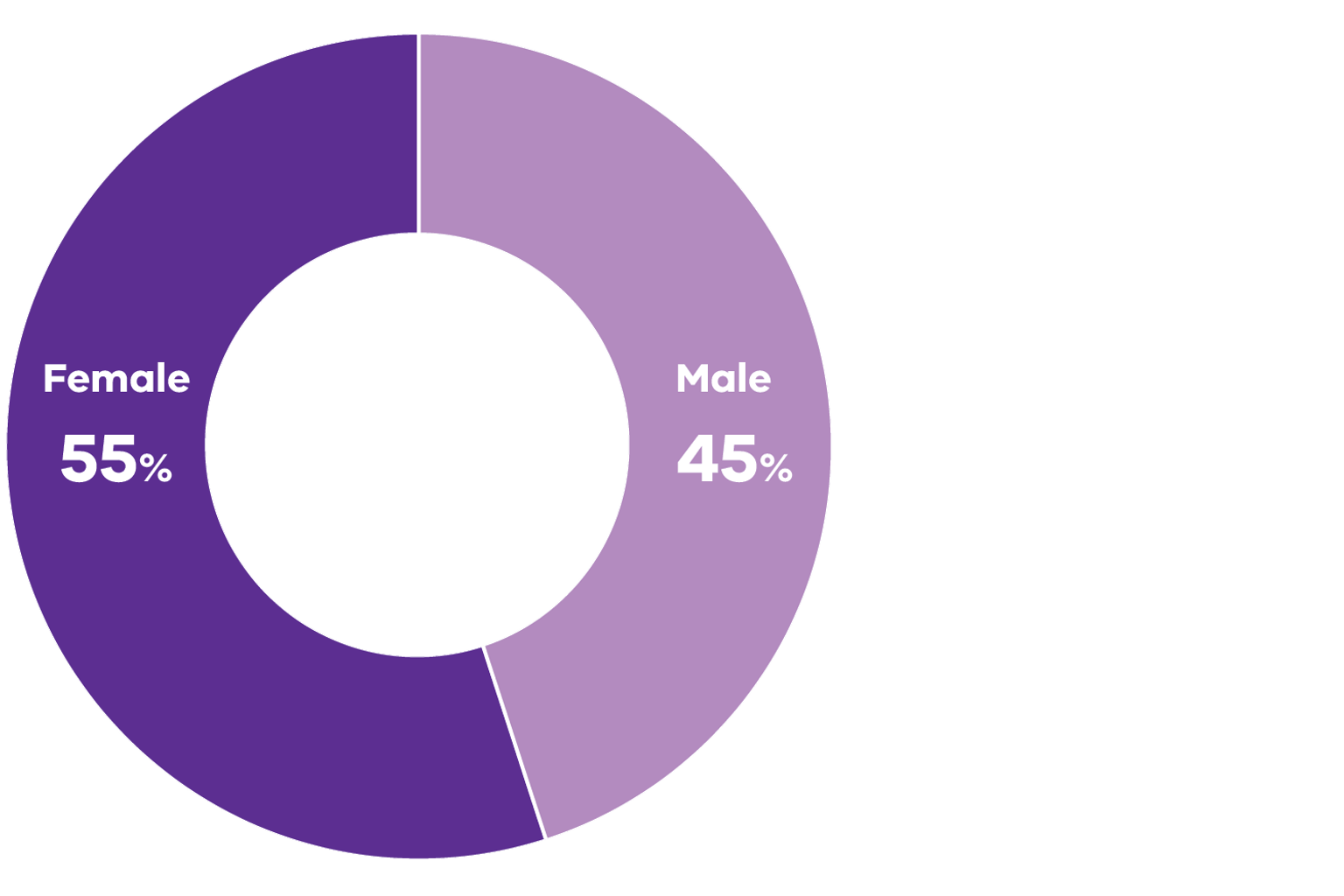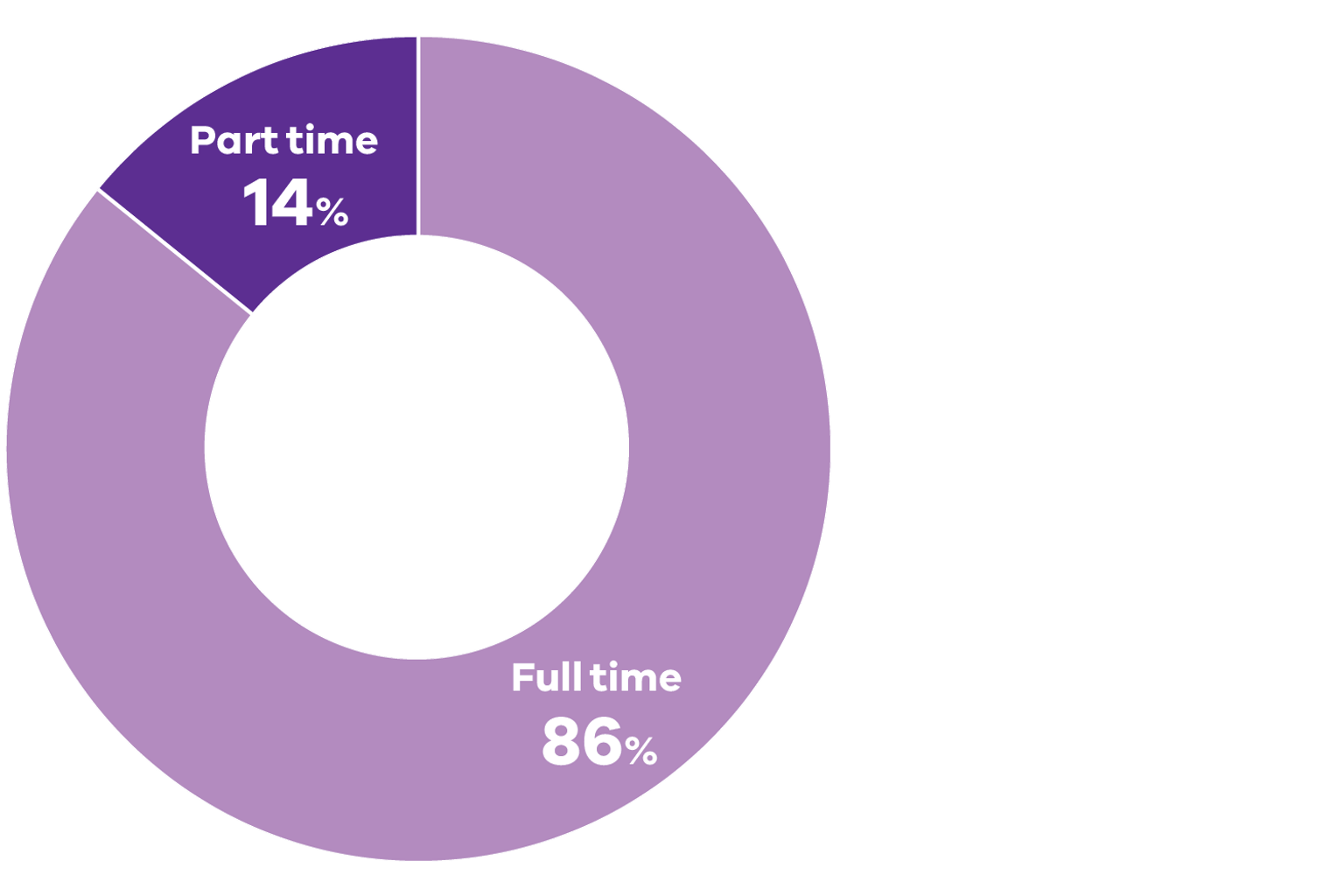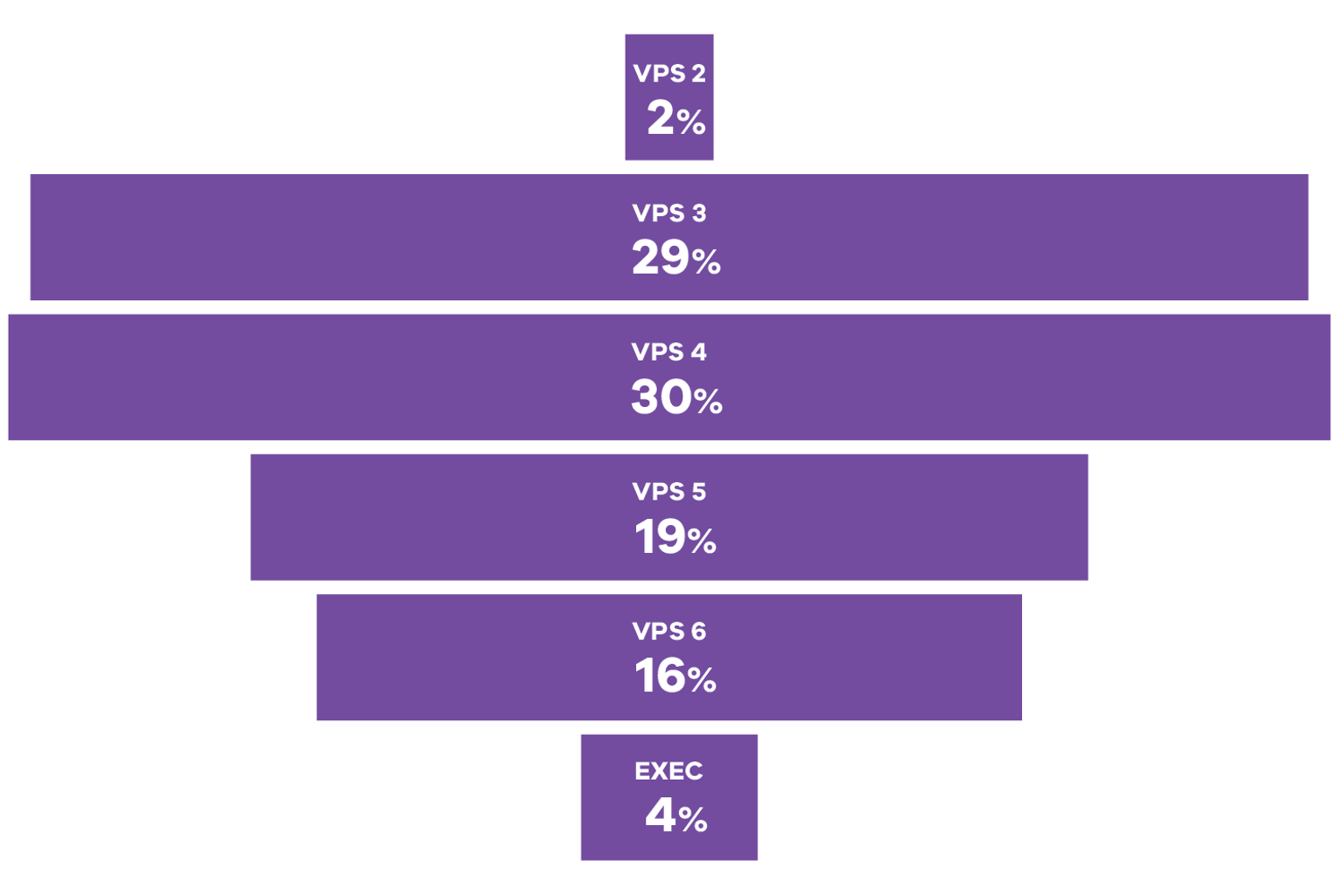- Date:
- 12 Feb 2024
This year, the Conservation Regulator achieved some significant outcomes, including substantial penalties for serious wildlife and firewood offences prosecuted in court. It was also pleasing to see another marked reduction in unattended campfires and continued big numbers of Victorians getting out into nature and protecting our wildlife.
Chief's message
Kate Gavens, Chief Conservation Regulator
Welcome to the Conservation Regulator’s Year in Review for 2022–23. This year, the Conservation Regulator achieved some significant outcomes, including substantial penalties for serious wildlife and firewood offences prosecuted in court. It was also pleasing to see another marked reduction in unattended campfires and continued big numbers of Victorians getting out into nature and protecting our wildlife.
In 2022–23 we saw wetter than normal weather conditions causing flooding and reduced campfire risks over summer. We saw a significant increase in reports and evidence of the illegal take of firewood, likely associated with cost-of-living pressures creating a high demand for firewood resources during winter. Urban development continues to lead to more frequent interactions between humans and animals in our forests, backyards, and beaches.
This has prompted the Conservation Regulator to dedicate more resources to educating the public about how to interact safely with unique and valuable Victorian wildlife and monitoring their protection.
In May 2023 the Victorian Government announced that commercial native timber harvesting in Victoria’s state forests would cease on 1 January 2024.
As the regulator of native timber harvesting, the Conservation Regulator will continue to regulate the industry through this transition. During 2022–23, we ensured we were agile as this industry underwent significant change. We also modified our approach in response to a review by the Victorian Auditor General’s Office. The review acknowledged the positive regulatory changes we have made over the last three years of operation and recommended 10 actions to support further improvement, eight of which have already been implemented.
We continue to focus on our regulatory priorities, understanding risk and ensuring our activities have the most impact on protecting our environment. Through continued investment in our people and approach, we work to reduce the barriers to compliance faced by the community, while continuing to provide education, compliance support and enforcement of the law.
In the last 12 months, we have increased our engagement with community by participating in a variety of local events and increasing our presence and visibility on public land through proactive patrols across the State.
Our outcomes would not be possible without the valuable input of community members, stakeholders, and partners who have continued to provide feedback and report non-compliance. We hope to continue strengthening these networks and building more relationships to help us identify risks and gather information to better protect Victoria’s native environments and wildlife.
I hope you enjoy reading about our achievements in this Year in Review. I look forward to continuing our work and sharing it with you in 2023–24.
About us
The Conservation Regulator oversees the regulation of timber harvesting, public land use, biodiversity, and fire prevention. We are a specialist regulator, established within the Department of Energy, Environment and Climate Action (DEECA).
We have refined our regulatory practice over the last four years and continue to strive to improve our operation and procedures. We continue to focus on opportunities for collaboration and strengthening our relationships with Victorian communities, Traditional Owners, land managers, co‑regulators, and other stakeholders.
Our mission
To be an effective, trusted, best practice regulator.
Our vision
To create and maintain liveable, inclusive, sustainable communities and thriving natural environments.
Our regulatory outcomes
We regulate to achieve three key outcomes:
- Equitable and safe access to public land and use of natural resources
- Protected natural and heritage values
- Sustainable communities – social, economic, and environmental.
Our regulatory priorities
Regulatory priorities support the Conservation Regulator to focus efforts on the greatest environmental risk and what is most important to the Victorian community.
In 2022–23, our regulatory priorities remained unchanged given the continued trends of high public land visitation, increased sales of off-road vehicles, demand for native wildlife as pets, changes in energy demands increasing illegal firewood theft, and consistently high numbers of illegal campfires, particularly over public holiday periods.
Progress on our regulatory priorities outlines our progress against addressing each of these regulatory priorities.
Our compliance and enforcement approach
The Conservation Regulator focuses its effort where there are the most significant risks to maximise the outcomes achieved. We do this by considering:
- The level of risk non-compliance poses to our regulatory outcomes.
- Our ability to reduce risk to our regulatory outcomes.
- The most effective use of our regulatory resources.
This approach recognises that it is not practical or appropriate to take compliance and enforcement action in response to every alleged or suspected breach. Our effort and actions will be focused where there is the greatest risk to our regulatory outcomes and where we can efficiently and effectively reduce that risk.
We consider factors such as whether breaches of the law were intentional, reckless or repeated, and the impact of the breach in our decision making. This means that our approach will shift depending on the circumstance from providing information and advice about how to comply with the law through to imposing fines, cancelling licences and permits, or prosecuting for serious offending.
We monitor compliance with the law to prevent harm to the environment wherever possible. Through monitoring we identify non-compliance and maintain a credible threat of detecting those who are engaging in illegal activities.
We also take preventative action through media, engagement, and educational activities, to raise awareness of regulatory requirements and how to comply with the law, responding to reports of crime as they arise.
Progress on our regulatory priorities
2022-23 was another great year where we utilised our risk-based and intelligence-led approach, supported by strong community engagement, to ensure compliance with the law.
Illegal campfires
Bushfires can have devastating and lasting impacts, as Victorians know all too well.
This is why we continue to prioritise community safety and environmental protection by reducing the risks from illegal and unsafe campfires.
For the second year in a row, wet weather conditions brought by a La Niña event reduced the risk associated with unattended campfires, although the potential harm to communities and the environment from illegal campfires remained. Between July 2022 and June 2023, a total of 444 unattended or abandoned campfires were reported on public land, compared to 532 in 2021–22 and more than 800 in 2020–21.
Most illegal campfires were reported in the Hume and Gippsland regions, comprising 80 per cent of total detections. Peak periods of illegal campfires frequently lined up with holiday periods and long weekends, with 135 detections in January 2023 and 104 in April 2023 across the State. Authorised Officers issued 31 official warnings for campfire offences and 53 infringement notices. In September 2022, two prosecution cases were finalised relating to campfire offences that occurred on Total Fire Ban days in 2021–22. The outcome was an order for one of the accused to donate to the Country Fire Association and the other to pay a fine.
Since inception, the Conservation Regulator has focused and sustained its efforts to engage and educate communities about campfire safety.
During the 2022-23 summer, we partnered with Forest Fire Management Victoria to trial an educational campfire bucket initiative in the Alpine Shire region, designed to teach campers about safely maintaining and extinguishing their campfires.
Following positive feedback from the public, we are extending the initiative state-wide in 2023–24. By distributing reusable metal buckets branded with campfire information, we hope to reduce the bushfire risk from escaped campfires on public land.
Importantly, as we look ahead to summer in 2023-24, authorities have declared an El Niño weather pattern to form across eastern Australia, bringing warm, dry weather and increasing the risk and damaging effects of bushfires. The Conservation Regulator’s continued engagement with communities through patrols, messaging, and targeted campaigns will help raise awareness of campfire safety regulations and will be key to reducing the dire consequences illegal campfires on public land can have.
Illegal possession of wildlife
Victoria is home to a range of unique native animals, and whether being cared for in captivity, visiting our backyards, or roaming free on public land, they must be treated humanely, and obtained and traded legally.
Over the last 12 months, the Conservation Regulator continued its work in protecting Victorian wildlife by identifying, investigating, and prosecuting those responsible for wildlife crimes.
Unfortunately, many animals are unlawfully taken from the wild every year to be illegally traded, trafficked, and kept for personal use, and they are often subject to cruel conditions and transport methods. The removal of wildlife from their natural environments can also create significant and lasting damage to wildlife populations and habitats.
The Conservation Regulator relies on public information about suspicious behaviour or illegal activities to support our efforts to combat wildlife crime. Our partnership with Crime Stoppers Victoria and strong relationships with other wildlife agencies, including Zoos Victoria, Agriculture Victoria, and RSPCA are critically important for the Conservation Regulator’s work to effectively gather information, investigate, and reduce wildlife crime.
In 2022–23, the Conservation Regulator laid 146 charges relating to wildlife, including illegal possession, harm, and cruelty offences. In addition, four official warnings and 39 infringement notices were issued (This figure incorporates infringement notices issued by the Conservation Regulator as part of Operation SoHo which was a joint operation with Parks Victoria).
Educating the community about responsible ownership of wildlife has also become a focus for the Conservation Regulator, as our data continues to show a steady increase in license applications and many of the wildlife crime reports we receive relate to issues of neglect, rather than intentional cruelty. As such, the Conservation Regulator is continuing to help wildlife licence and authorisation holders understand the law and how to comply, through inspections, monitoring and guidance on our website.
Raising awareness of illegal trade of wildlife and exotic pests
Once again, we partnered with Crime Stoppers Victoria and Agriculture Victoria to raise awareness about the illegal trade of wildlife and exotic pests. In October 2022, we launched the Don’t Buy In campaign aimed at stopping people buying pets that have been illegally brought into the country or taken from the wild.
The coordinated campaign involved targeted messaging and advertising on social media and online marketplaces, such as Facebook and Gumtree, to educate buyers on how to legally acquire and keep wildlife, including information about types of animals and licences. Online marketplaces and social media have made the illegal sale of native animals easier. The Conservation Regulator is encouraging people to be prepared before buying wildlife and to be alert to dodgy dealers, so they can avoid inadvertently supporting the trade of illegal wildlife. Between July 2022 to June 2023, there was a 12.5 per cent increase from the previous year in wildlife crime reports made to Crime Stoppers Victoria. These reports help us to understand wildlife crime trends and conduct investigations. We thank the public for these reports and urge you to continue coming forward.
Operation SoHo
Operation Save our Hoodies (SoHo) is a coast-wide operation led by the Conservation Regulator which focuses on the protection of native hooded plovers (Thinornis rubricollis) during their crucial summer breeding season.
The operation, in its second season, is run in partnership with Parks Victoria and BirdLife Australia, and involves both educational and enforcement actions to support the survival of the threatened beach‑nesting bird.
Hooded plovers are currently listed as vulnerable under both the Victorian Flora & Fauna Guarantee Act 1988 and the Commonwealth Environment Protection & Biodiversity Act 1999. Environmental factors such as king tides, extreme heat events and erosion threatened the tiny birds, as well as significant threats from humans who risk scaring them off or trampling on their nests, and dogs which often catch and kill chicks.
From September 2022 to April 2023, Authorised Officers from the Conservation Regulator and Parks Victoria partnered with volunteers from BirdLife Australia to conduct 232 patrols along the Victorian coast, engaging with more than 1,570 people. The collaborative enforcement effort of Parks Victoria and the Conservation Regulator has resulted in 83 people fined for various offences, including disturbing nesting birds and owners not in control of their dogs in hooded plover habitat.
Another year of protection efforts under Operation SoHo has helped at least 40 (Estimated by BirdLife Australia) more hooded plover chicks fledge along Victoria’s coast, bringing the total adult population to approximately 750 birds.
- 1,570+ community engaged
- 83 individuals fined
Two men pay the price for illegal animal possession
In separate cases, two Victorian men were ordered to pay a total of $6,800 after Authorised Officers caught them illegally keeping snakes as pets.
In April 2023, a Nichols Point man was fined $1,000 and ordered to pay $4,600 in legal costs after he pleaded guilty to three offences related to the cruel treatment and illegal possession of an endangered Murray Darling Carpet Python. The fine followed a Conservation Regulator investigation last year, after the man’s landlord found the snake at his rental property housed inside an enclosure filled with faeces and no drinking water.
The snake was re-homed by the Conservation Regulator.
In another matter, a Nagambie man was convicted and ordered to pay more than $1,200 in fines and vet costs after Authorised Officers found him in possession of a two-metre-long boa constrictor in 2021.
The man pleaded guilty to one count of keeping a controlled pest animal without authorisation, an offence under the Catchment and Land Protection Act 1994. Authorised Officers inspected his house after receiving reports he was keeping a carpet python without a licence, but instead found what they believed to be a boa constrictor. Keepers at Zoos Victoria confirmed the species based on the size, markings, and colouration of the snake. Boa constrictors are native to South America and the Caribbean and are classified as a pest animal in Australia. Pest animals pose a serious threat to the environment and community health and can only be kept with certain licences.
- $6,800 penalty issued
Koalas at Cape Bridgewater
In December 2022, a harvesting contractor was fined $20,000 for their part in clearing koala habitat at a Cape Bridgewater property between November 2019 and January 2020, which impacted more than 200 koalas, 70 of which were injured and killed or had to be euthanised.
The contractor pleaded guilty to one charge under the Prevention of Cruelty to Animals Act 1986 for an act, which a Magistrate said likely could have caused unreasonable pain or suffering to that property’s koala population.
It was one of two businesses hired by the landowner to clear vegetation from the former operational blue gum plantation. The contractor used an excavator to remove stumps, some of which exhibited regrowth and that served as koala habitat, in a discrete part of the property. The contractor was responsible for a minority of the clearing at the property.
This court outcome follows a Conservation Regulator investigation into reports of injured and starving koalas at the Cape Bridgewater property in February 2020. In addition to the outcome above, the landowner and a separate forest and earthmoving business were charged in December 2021 with 126 offences each under the Prevention of Cruelty to Animals Act 1986 and the Wildlife Act 1975, including 18 aggravated cruelty charges for causing fatal injuries. Both cases are still before the Warrnambool Magistrates’ Court.
- $20,000 penalty issued
- 2 cases pending
Permits and licensing
Licences and permits help protect our wildlife and ensure that interactions with wildlife are careful, ethical, sustainable, and meet the requirements of the Wildlife Act 1975.
The Conservation Regulator issues many different types of wildlife authorisations, and applications from the public continued to trend upwards this year, with a 9.5 per cent increase in Private Wildlife Licences issued or renewed from 2021-22. Spikes in application numbers are often seen during school holidays and in the lead up to Christmas.
To make compliance simpler and easier, we have made improvements to the way we assess and issue authorisations, with a particular focus on digitisation. In early 2022, we began creating online forms for several types of licences, including applications for Import/Export permits, Private Wildlife Licences and Authority to Control Wildlife (ATCW) permits. Since then, more than 6,100 Private Wildlife Licences, 1,100 Import/Export Permits and 2,900 ATCWs have been applied for online.
Wildlife licence holders are required by law to keep up-to-date records of all wildlife in their possession. Each year, licensees must submit an Annual Return form to the Conservation Regulator which details any changes to their collections, including if animals have been acquired, traded, or have died.
This data helps us to understand what wildlife is being held and monitor any trends, such as high death rates or concentrations of dangerous species (such as venomous snakes).
Unfortunately, the compliance rate for annual returns has historically been very low, but this year the compliance rate increased by nearly 10 per cent, up from 47 per cent in 2021–22. We attribute this improvement to better communications and reminders from the Conservation Regulator about the importance of submitting a return, as well as the introduction of an online tool, with more than 6,700 licence holders choosing to submit their Annual Return digitally this year.
All licences and permits have conditions that help protect the welfare of any wildlife held in captivity. The Conservation Regulator provides information about permit holder obligations at the point of application and during renewals. We also publish guidance for permit holders online, including the Koalas in Blue Gums Regulatory Guide and the Rehabilitator Authorisation Guide. We work to monitor compliance with licence and permit conditions, and ensure any non-compliance is investigated.
Permits and licence types
There are many different type of licences and permits issued by the Conservation Regulator, which help ensure safe, legal, and ethical interactions between people and native wildlife.
Permissions that we are responsible for include:
Authority to Control Wildlife
Allows landholders and land managers who have issues with wildlife causing damage to buildings, pastures, crops, or other property, or which pose risks to human health and safety, to manage these problems. An authority may include permission for lethal and non-lethal control methods.
Commercial Wildlife Licence
Allows for the commercial use of wildlife, including selling wildlife in pet shops, keeping wildlife in zoos, as well as taxidermy and other processing of wildlife products.
Private Wildlife Licence
Allows people to keep wildlife at their private residences.
Wildlife Shelter Authorisation
Allows people to care for and rehabilitate injured, ill, or orphaned wildlife for release back into the wild.
Wildlife Foster Carer Licence
Allows people to care for and rehabilitate injured, ill, or orphaned wildlife for release back into the wild.
Research, Conservation, Management and Nursery Authorisation
Allows people to conduct research where activities may be impacting on wildlife, protected flora or fish, but are necessary for improving scientific understanding, such as attaching radio collars to track wildlife.
Forest Produce Licence
Allows individuals and private companies to cut, dig, or take away material from state forests for personal or commercial use. Two Forest Produce Licences were issued in 2022-23.
Statement of Regulatory Intent –Regulating the protection of Wildlife
The Conservation Regulator’s role and responsibilities in wildlife regulation are outlined in our Statement of Regulatory Intent – Regulating the protection of Wildlife.
The statement sets out how we regulate the protection, conservation, and activities concerning wildlife, including sustainable use and access. It also defines our public commitments and performance measures to help the community and regulated entities understand what they can expect from us as a regulator.
Performance measures for regulating the protection of wildlife
The following tables contain an update on each of the measures contained in the statement.
Permissions
Number of Wildlife permission by type issued.
| 2021-22 | 2022-23 | ||
|---|---|---|---|
| Authority to Control Wildlife | Total | 2,148 | 2,655 |
| Commercial Wildlife Licence | Total | 268 | 264 |
| Issue | 41 | 61 | |
| Renew | 227 | 203 | |
Private Wildlife Licence Including Dingo licence | Total | 7,377 | 8,083 |
| Issue | 3,436 | 4,004 | |
| Renew | 3,941 | 4,079 | |
| Wildlife Shelter Authorisation | Total | 257 | 316 |
| Issue | 16 | 25 | |
| Renew | 241 | 291 | |
| Wildlife Foster Carer Licence | Total | 246 | 235 |
| Issue | 68 | 34 | |
| Renew | 178 | 201 | |
| Wildlife Import/Export Permit | Total | 1,568 | 1,422 |
| Research, Conservation, Management and Nursery Authorisations | Total | 358 | 388 |
Sets standards, inform and educate, supporting compliance
| 2021-22 | 2022-23 | |
|---|---|---|
| Conservation Regulator publications | See Key publications | |
| Wildlife licence holders that submitted required Annual Return | 47% | 56% |
Monitoring compliance
| 2021-22 | 2022-23 | |
|---|---|---|
Licence, permit and property inspections. Conduced to determine compliance with conditions. | 148 | 298 |
Enforcement of the law
In response to non-compliance, in line with Conservation Regulator Compliance and Enforcement Policy for Wildlife.
| 2021-22 | 2022-23 | |
|---|---|---|
| Infringement Notices issued | 28 | 39 |
| Official warnings | 3 | |
| Prosecution charges laid | 18 | 127 |
Collaborate
| 2021-22 | 2022-23 | |
|---|---|---|
| Number of calls and emails received and assessed by our Customer Contact Centre concerning wildlife | 4,645 | 5,148 |
Illegal commercial timber harvesting
The Conservation Regulator is responsible for regulating commercial native timber harvesting in state forests.
We utilise a multi-faceted regulatory approach to ensure the timber industry complies with the law and involves undertaking proactive inspections, audits, and investigations, gathering intelligence, and responding to reports of non-compliance.
The approach undertaken and outcomes for 2022–23 are detailed further in Regulating timber harvesting.
Illegal take of firewood
The illegal take of firewood for personal use or commercial sale risks the survival of many of Victoria’s native mammals, reptiles, birds, and the health of important ecosystems.
Victoria has two domestic firewood collection seasons per year, in autumn and spring, in which the Victorian community can collect firewood from designated firewood collection areas legally and for free. There are strict rules around the type and amount of wood that can be collected to preserve wildlife habitat and protect community resources.
The Conservation Regulator continued to target illegal firewood activity in 2022–23 through forest patrols, concealed cameras, and other methods to detect offences, and engaging with the community through the media and other channels to support compliance. We laid 109 charges related to the illegal removal of firewood from Victorian public land.
Across the state, reports and direct observations of illegally felled trees and subsequent timber removal, primarily for the purposes of firewood supply, have significantly increased across DEECA and Parks Victoria managed estates. Many public land areas, particularly those with desired firewood species such as River Red Gum, are being left devoid of standing, dead trees. River Red Gum is typically found along water courses and floodplains and old, standing dead trees provide important habitat for tree dwelling mammals, birds and reptiles that rely on hollows for shelter and nest sites.
The formation of hollows in eucalypt species takes decades to occur and the removal of these trees diminishes the ability of these public land spaces to provide important habitat for Victoria’s native wildlife. The Conservation Regulator will continue to direct and focus its efforts and resources to reduce the impact this illegal activity has on the conservation values of Victoria’s public land.
Reports of illegally felled trees and timber theft have increased significantly over the past five years, largely in Victoria’s colder months. Cost-of-living pressures have increased demand for firewood, while wildlife populations and ecosystems are particularly vulnerable after recent extreme weather events. The Conservation Regulator continues to direct effort towards addressing these concerning risks to wildlife and ecosystems.
Operation River Gum
Operation River Gum was our dedicated firewood operation focusing on the detection, investigation, and prosecution of illegal firewood offences in areas of highest environmental concern along the Murray River corridor in the Loddon Mallee and Hume Regions.
The operation was designed and led by the Conservation Regulator in partnership with DEECA Forest and Fire Operations Division and Parks Victoria. It utilised traditional regulatory activities, such as patrols and penalties, and tested some novel approaches to community engagement to educate them on the impacts of illegal firewood collection.
While the on-ground operations concluded in November 2022, many of the offences detected were finalised in court in 2022–23. The Conservation Regulator has so far brought charges against 17 people and finalised six cases in court with penalties including criminal convictions, fines between $1,000 and $7,500, and forfeiture of various seized items to the Crown. Authorised Officers also issued an additional 37 infringement notices for various offences related to illegal firewood removal.
We also trialled additional methods to engage with buyers and sellers of firewood in Victoria to inform them of the impacts of illegal firewood collection. We sent a direct mailout to 87 firewood sellers and ran an online advertising campaign on Facebook Marketplace and Gumtree targeting potential firewood buyers, which reached 1.2 million people.
- 1.2 million community members engaged
- 17 accused prosecuted
- 37 penalties issued
South Australians fined for firewood offences in Victoria
Three South Australian men were fined a combined total of $4,810 for illegally cutting and taking four cubic metres of red gum trees for firewood from the Nangeela State Forest in September and October 2022.
Two of the men received infringements for illegal off-road driving under the Land Conservation (Vehicle Control) Regulations 2013, while all three were fined for cutting and taking the timber, a breach of the Forests Act 1958.
Conservation Regulator Authorised Officers caught the men, all aged in their 20s, on concealed cameras installed near the border to help target illegal firewood operations.
- $4,810 penalty issued
Convictions and fines for Goulburn Valley firewood thieves
Two men from the Goulburn Valley were convicted and fined a combined amount of $12,500 in January 2023 after they admitted to illegally cutting and taking timber from the Lower Goulburn National Park and the Loch Garry Wildlife Reserve.
One Congupna man pleaded guilty to 11 charges relating to disturbing wildlife habitat, illegal firewood collection, illegal off-road driving and obstructing an Authorised Officer in the execution of their duty. The Presiding Magistrate also ordered the destruction of the man’s two chainsaws and dual trailer.
The Shepparton man, who has previously been convicted of similar offences, pleaded guilty to three charges of illegally cutting timber, disturbing wildlife habitat, and driving off-road.
Conservation Regulator Authorised Officers detected the pair after they were captured on concealed cameras installed as part of Operation River Gum.
- $12,500 penalty issued
Illegal vehicle use
Trail bike riding and four-wheel driving has increased in popularity since the COVID-19 pandemic, and while they are good ways to explore Victoria’s great outdoors, there are strict rules about where vehicles can go to protect drivers, riders, and the environment when out exploring.
The Conservation Regulator targets illegal vehicle use on public land because of the serious risks it poses to sensitive ecosystems, cultural heritage, and personal safety. This includes activities related to the construction of illegal training grounds, such as illegal campfires and littering. Illegal vehicle use remained the most common offence category in 2022–23. Authorised Officers issued 167 infringement notices and 28 official warnings to four-wheel drivers and trail-bike riders for off-road-related offences, including using roads closed to the public or illegal single trails. Nearly 50 per cent of vehicle-related offences and observations were made in the Hume region. Many major 4WD and off-road motorcycle events, trade shows, races, and rallies returned following the end of pandemic restrictions, and the Conservation Regulator was able to use these events as opportunities to engage with and educate the community.
Operation sprocket
Operation Sprocket is a state-wide operation led by the Conservation Regulator that educates recreational trail bike riders on how to ride safely, legally, and sustainably on Victoria’s public land.
The operation completed its third year during 2022-23, with a continued focus on promoting personal safety and environmental protection to the state’s community of approximately 60,000 licensed trail bike riders. Trail bike accredited Authorised Officers attended several off-road events and recreational trail bike rallies, engaging with more than 3,600 riders to raise awareness of safe riding behaviours, protective equipment, and Personal Locater Beacons (PLBs).
Over the past three years, trail bike riding has increased significantly in popularity, with off-road motorcycles making up nearly half of all motorcycle sales in 2022. Sadly, more than 30 per cent of Victoria’s reported motorcycle accidents occur in state forests and parks, and riders increase both their risk of injury and significant environmental damage if they illegally leave formed roads on public land.
The Conservation Regulator’s Trail Bike Safety Initiative works in partnership with Victorian motorcycle associations and road safety authorities to actively engage with and influence the behaviours of off‑road motorcycle riders to reduce the amount and severity of crashes, as well as their environmental impact.
- 3000+ riders engaged
Bairnsdale man pays the price for off‑road environmental damage
A Bairnsdale man was convicted and fined $1,500 in September 2022 for two illegal off-road driving offences he committed in the Nunniong State Forest in October 2021.
The man pleaded guilty to forcing open and damaging a seasonal closure gate and driving on a closed road in a sensitive alpine area. The Presiding Magistrate also ordered the man pay $244.86 in additional legal costs.
- $1,500 penalty issued
Figure 3 provides a month-by-month breakdown of the number of warnings and penalties issued and the number of accused prosecuted.
Man faces 100+ charges over northeast land clearing
The owner of an earthmoving business was charged with 127 offences relating to illegal native vegetation clearing and habitat destruction after allegedly bulldozing more than 60 large native trees on public land in and around the Mount Lawson State Park in April 2022.
Conservation Regulator Authorised Officers investigated following a report of large machine tracks and alleged illegal land clearing behind private property that adjoins the park.
Environmental experts assessed the site and found the felled trees would have provided significant habitat for native wildlife, including the endangered gang-gang cockatoo, and the damage will have lasting impacts on biodiversity values.
As the regulator of public land in Victoria, it’s our responsibility to investigate and, where appropriate, prosecute cases of illegal native vegetation removal on Crown land.
- 127 charges laid
Key publications
We published several documents during 2022–23 to help community and industry members understand where we focus our efforts and how they can support compliance. These publications are critical to meeting our regulatory responsibilities, and by providing appropriate guidance we can prevent harm from occurring in the first place.
Regulatory Priorities for 2022–23(opens in a new window)
The updated annual Regulatory Priorities for 2022–23 outlined our state-wide priorities and recognised the unique context and compliance risks facing Victoria’s environments.
Wildlife Rehabilitator Authorisation Guide(opens in a new window)
Wildlife rehabilitators are regulated by conditions that enforce the minimum standards required for the humane treatment and successful rehabilitation of wildlife in care. This authorisation guide explains the conditions of authorisation, and the objectives of each condition to assist authorisation holders to comply.
Injunctions, Enforceable Undertakings and Statute of Limitations for commercial timber harvesting offences (opens in a new window)
The Conservation Regulator was established to oversee key regulatory functions including the compliance and enforcement of timber harvesting in State forests. The website was updated to clarify the use of available regulatory tools for timber harvesting offences, including injunctions and enforceable undertakings. In addition, guidance was published explaining amendments to the statute of limitations and how this may impact enforcement action for timber harvesting offences.
Conservation Regulator brochures
- Can I? Can’t I? Campfires and barbecues
- Can I? Can’t I? Vehicle use on Victorian public land
- Can I? Can’t I? Domestic firewood collection from Victoria’s public land
- A guide to boating and swimming around whales, dolphins, and seals
Upgrades to our systems and processes
We are always looking for ways to improve our systems, processes, and tools, to enable more effective and efficient regulation. Since being established, the Conservation Regulator has been working to progressively procure and implement modern business systems, including digitising regulatory interactions where appropriate to reduce unnecessary paperwork and the associated delays.
2022-23 initiatives
Licensing system
- We are now turning our attention to procuring a new licensing system to further improve the administration and the digitisation of our licences and permits.
- Underway
Case management system
- In 2022-23, developing a new Case Management System has been the Conservation Regulator’s priority. The Case Management System will be implemented in 2023-24.
- Underway, due quarter 2, 2024
Intelligence system
- Our new regulatory intelligence database commenced in 2021. We continue to refine and improve the intelligence database.
- Complete
Digital application forms
- Digital application forms for most regulatory licence and permit applications, inclusive of annual returns that are required to be submitted each year by Wildlife Licence holders, were introduced in 2022-23. Digital application forms have reduced time between application submission and issue of private wildlife licences from an average of 21 days in 2018 to an average of 10 days in 2022.
- Complete
Working together to achieve outcomes
Our focus on engagement
Engaging with the community is a key part of education, supporting compliance, and understanding what the community values and expects. In 2022-23, the Conservation Regulator attended numerous events to engage with the community, stakeholders, and other public land authorities across our regulatory priorities.
We appreciate any opportunity to meet members of the community to discuss our role and talk to them about how they can help protect Victoria’s environment and native wildlife.
2022-23 highlights
Outdoors Victoria conference
An opportunity to engage with outdoor recreational operators and educators and talk to them about what we do, why it’s important, and how we can work together to protect our forests, including how to report any non‑compliance.
Phillip Island Whale Festival
Attending and presenting at the Phillip Island Whale Festival to help people better understand how to share the water with whales and other marine mammals safely.
Great Southern Bird Expo
Attending the Great Southern Bird Expo which provided a great opportunity to engage with wildlife licence holders and educate the public on the rules and requirements of keeping native birds as pets.
Arborist Festival
Speaking at the Arborist Festival on the legislation and regulations relevant to arborists, and the importance of managing wildlife while completing their work.
Crime Stoppers Victoria
Multiple Crime Stoppers Victoria events, including university orientation weeks.
Schools and universities
Numerous school visits and university presentations.
Operation Leonina
By the time an elephant seal settled on a quiet beach on the Mornington Peninsula for a few weeks to rest and moult his winter coat in January 2023, he had already built quite the fan-base after making international headlines for his escapades across the bay at Point Lonsdale.
Affectionately named Henry, the juvenile elephant seal made a temporary home and routine at the beach at Camerons Bight and with no signs of him leaving, the local land manager Whitecliffs Foreshore Reserve Committee of Management decided to close the area to make sure crowds kept their distance and Henry could rest peacefully.
As interest in the elephant seal’s behaviour and welfare increased, the Conservation Regulator led protection efforts under Operation Leonina and partnered with the Foreshore Reserve team, Forest Fire Management Victoria, and Peninsula Security Services for round-the-clock education and enforcement action. The Marine Response Unit, Melbourne Zoo, Mornington Peninsula Shire Council, and Victoria Police also helped manage the situation.
On 15 February, we said goodbye to Henry as he began his journey south and the beach was reopened to the public.
A huge thank you to all teams involved!
Regulating timber harvesting
Over the last 12 months, the Conservation Regulator remained focused on overseeing the compliance and enforcement of timber harvesting operations in state forests, even as the overall volume of harvesting was significantly lower than in previous years due to civil litigation and other factors.
A holistic approach to timber harvesting regulation
On 23 May 2023, the Victorian Government announced native timber harvesting will cease on 1 January 2024. Since the announcement, the Conservation Regulator has continued to regulate the industry focusing on harm prevention and biodiversity protection. This focus will continue as the industry transitions.
Figure 4 summarises how the Conservation Regulator works to ensure that the planning and conduct of timber harvesting operations comply with the law, and that important forest values are protected. In 2022-23, we continued to focus our regulatory effort on areas with potential for the greatest environmental harm and dedicate resources to reviewing and improving our processes. Approach to timber harvesting regulation
Proactive coupe inspections
The Conservation Regulator’s proactive Coupe Inspection Program focuses on preventing breaches of the law during timber harvesting, and identifying potential non-compliance post-harvest. Authorised Officers attend timber harvesting coupes to ensure compliance with a variety of priority areas, including waterway crossings, retained vegetation and exclusion zones, and coupe infrastructure, such as roading.
With a commitment to inspect 30 coupes each year, the Conservation Regulator delivered 56 proactive timber harvesting coupe inspections across Victoria during 2022–23, scrutinising duty-holder behaviour and delivering on improved compliance outcomes.
The Conservation Regulator has also actively engaged with community and duty-holders to explore areas where regulatory requirements are not well understood, and new guidance can be developed to improve compliance and environmental outcomes.
Reports of non-compliance and threatened species detections
The Conservation Regulator encourages members of the public to submit reports of alleged non-compliant timber harvesting activities, and the detection of threatened species or forest values found in or adjacent to planned timber harvesting locations. Assessing these reports is a priority for the Conservation Regulator and is undertaken by experienced Authorised Officers.
In 2022–23, we received and assessed 78 threatened species reports. We processed and closed 37 threatened species reports (including reports made in the previous financial year), and 74 of these reports remain under assessment. Several threatened species reports contain information about greater glider and yellow-bellied glider detections and have resulted in protections from timber harvesting where thresholds set in the relevant threatened species action statements are met. We received six reports of Leadbeater’s Possums in 2022–23, all of which resulted in the implementation of protection area that excludes timber harvesting around the detection.
Throughout the year we received and assessed 24 reports of alleged non-compliance and closed 25 reports (including some reported to the Conservation Regulator in previous financial years). 18 reports of alleged non-compliance remain under assessment.
The Conservation Regulator has also engaged with other agencies such as the Environment Protection Authority Victoria (EPA), WorkSafe, and Melbourne Water to drive an increased regulatory presence, and improve compliance capabilities and attitudes. Working with our valued partners from the EPA led to one Waste Abatement Notice being issued by Conservation Regulator Authorised Officers under the Environment Protection Act 2017 in 2022–23, resulting in the removal from state forest of contaminated soil posing risks to the environment and human health. Throughout the year Authorised Officers also engaged with duty-holders present at timber harvesting coupes to educate them about their new obligations under the Environment Protection Act 2017 where it related to their undertaking of timber harvesting operations, including the appropriate management of hydrocarbons (oil and petroleum products) relating to their harvesting machinery.
The Conservation Regulator issued five directions under section 70 of the Sustainable Forests (Timber) Act 2004. Section 70 direction notices allow the Conservation Regulator to require timber harvesting operators and duty-holders to take action to address non-compliance, prevent harm or remediate issues where these occur.
One of these directions was issued to prevent timber harvesting from occurring within in the Lerderderg State Forest, protected by a Special Protection Zone, prompted by information received from the community. This direction protected important forest and heritage values present in this area.
Five exciting years of biodiversity discovery and protection
In June 2023, we marked five years of the Forest Protection Survey Program and celebrated the program’s work and outcomes, including completion of 3,920 surveys within 1,784 coupes, and recording of 85,000 observations of plant and animal species in Victorian forests.
15,500 of those observations are of threatened species, including 744 observations of Leadbeater’s Possums which resulted in 4,900 hectares of forest specially protected as habitat. The Forest Protection Survey Program has also made an impact beyond timber harvesting through its significant contribution to the knowledge of species ranges and habitat, and the exciting identification of new species in Victoria. Some highlight finds are:
- Four new species of freshwater crayfish and one of Viola.
- New populations of Mt Cole and Colquhuon Grevilleas.
- The first record of a Pomaderris viridis in East Gippsland.
- An extended home range for the endangered long‑footed potoroo in the High Country.
Almost 330 giant burrowing frog tadpoles; a vulnerable species thought to be lost in the 2019‑20 bushfires.
The program has developed sophisticated procurement and data management systems, not only to better protect threatened species but also to support broader biodiversity conservation. Many of the program’s systems and processes support other parts of DEECA, such as threatened species risk assessments, post-fire assessments, and habitat distribution modelling.
Survey program data available at Forest Information Portal.(opens in a new window)
Forest Protection Survey Program
The Forest Protection Survey Program (FPSP) continued to conduct preharvest surveys to identify threatened or high-value biodiversity species in areas of state forests scheduled to be harvested. The surveys help record observations of target species that are required to be protected by VicForests.
Court results in early 2023 impacted VicForests operations resulting in a significant reduction to timber harvesting activities in the state’s east.
Consequently, the FPSP adapted to include surveying coupes scheduled for harvest in the state’s west and delivered more than 370 surveys that recorded approximately 18,500 observations, of which 2,000 are target species and values requiring legal protection.
Forest Audit Program
The Conservation Regulator delivered the Forest Audit Program (FAP) for the fourth year, maintaining an ongoing commitment to independently review timber harvesting operations using an annual, risk‑based approach.
The program measures compliance of commercial timber harvesting operations by auditing a representative sample of coupes harvesting in the 2022–23 financial year to assess a range of target themes, including:
- Protection of soil, water, and biodiversity values.
- Execution of in-coupe road design and construction.
- Implementation of forest coupe planning.
The 2022 Forest Audit Program inspected 32 coupes. Duty‑holder compliance has demonstrated a trend of improvement across the last three years. The mean compliance score of 96 per cent, above the 6-year average of 91 per cent. The Conservation Regulator is confident that improvements in compliance can, in part, be attributed to greater regulatory presence in timber harvesting.
Victorian Auditor General’s Office report – Regulating Victoria’s Native Forests
In October 2022, the Victorian Auditor General’s Office (VAGO) published its report Regulating Victoria’s Native Forests, which focused on the Conservation Regulator’s approach to responding to community reports submitted via the Forest Reports portal.
The VAGO report made a range of findings about the Conservation Regulator’s approach to regulation and acknowledged the significant progress made since the Regulator’s inception. The report outlined 10 recommendations for improvement, and DEECA subsequently approved or approved-in-principle all the recommendations.
The Conservation Regulator has made significant progress in implementing the recommendations, with 80 per cent fully acquitted by the end of 2022–23. (see Appendix A for details of each recommendation).
Statement of Regulatory Intent for Timber Harvesting Regulation
In 2019, the Conservation Regulator released its Statement of Regulatory Intent for Timber Harvesting Regulation and committed to publicly reporting on an annual basis on the performance measures it contained.
| Table 3: Performance measure results for timber harvesting compliance | Target | Result | Comment | |
|---|---|---|---|---|
| Per cent of coupes planned for timber harvesting that have been assessed in the Forest Protection Survey Program for the potential presence of target flora and fauna | 100% | 100% | Target met | |
| Per cent of coupes planned for timber harvesting that are field surveyed under the Forest Protection Survey Program with the potential presence of target flora and fauna | 64% | 64% | Target met | |
| Acknowledge receipt of reports of non-compliance | Workdays | <2 | 1.43 | Target met |
| Commence the verification of threatened species reports workdays | Workdays | <5 | 1.16 | Target met |
| Number of coupes harvested in previous year that were audited as part of the Forest Audit Program | 30 | 32 | Target met | |
| Number of coupes in which timber harvesting is underway or completed, that are subject to compliance inspection (includes spot checks for rainforest) | 30 | 56 | Target met | |
| Average time taken to investigate alleged or suspected non‑compliance | Months | <12 | 8 | Target met |
| Table 4: Activity measure | Result |
|---|---|
| Threatened species reports received | 78 |
Threatened species reports that underwent verification (The Conservation Regulator verifies threatened species reports where there is a relevant management action in the Code of Practice for Timber Production 2014, and where there is sufficient information in the report to enable verification) | 6 |
| Reports of alleged or suspected non‑compliance received | 24 |
| Reports of alleged or suspected non‑compliance investigated | 4 |
Our people and governance
The Conservation Regulator has more than 130 staff spread across the six DEECA regions of Victoria. Our staff perform both operational and strategic roles, working together to provide vital services to our community.
The Conservation Regulator Executive Leadership Team assumes a pivotal role in guiding the governance of the Regulator. Supported by internal governance structures, the Executive Leadership Team provides advice and support that enables the Chief Conservation Regulator to fulfil the Chief’s responsibilities, and oversees the areas of strategy, finance, risk, people and culture, information systems and operational performance.
Our organisational structure
The Conservation Regulator is led by the Chief Conservation Regulator and is comprised of four business units:
Regulatory Operations Branch
The Regulatory Operations branch leads and coordinates state-wide regulatory service delivery. Branch staff are responsible for conducting complex risk assessments, harm prevention campaigns, audits, inspections, investigations, and intelligence functions. The branch delivers strategic and effective risk-based and intelligence-led approaches to compliance for biodiversity, fire prevention, and use of public land through implementation of best practice frameworks, policies and supporting procedures and guidelines. The branch builds community confidence in the regulatory practices of DEECA, by implementing an open and transparent approach to information-sharing and decision-making, and by engaging with communities to inform how and where regulatory effort is targeted to address the greatest risks of environmental harm.
Strategic Operations Branch
The Strategic Operations Branch oversees key operational activities relating to timber harvesting and delivers on the strategic priorities of the Conservation Regulator. This includes the Timber Harvesting Compliance Unit and the Forest Protection Survey Program.
Regulatory Strategy and Permissions Branch
The Regulatory Strategy and Permissions Branch leads the provision of regulatory strategy, information and guidance, and capability development. It undertakes reform and delivery of regulatory permissions (licences, permits and authorities). The branch works closely with the Regulatory Operations and Strategic Operations branches to ensure its work can be effectively implemented and to support efficient, effective, and transparent regulatory service delivery.
Office of the Chief
The Office of the Chief leads and delivers on strategic projects, issues management, reporting, media and communications, stakeholder engagement and partnerships, as well as coordinating business planning and culture development functions. The Office of the Chief works with other Conservation Regulator branches, the Office of the Deputy Secretary, DEECA’s regional and corporate media and communications units, and co-regulators to support our mission and regulatory obligations.
Our people
The Conservation Regulator is committed to investing in the development of our people who underpin the delivery of our regulatory activities.
2022-23 initiatives
Capability Framework
Launched our Capability Framework to provide an overview of the capabilities, knowledge, behaviours, and skills required across the Conservation Regulator and to support individual and organisational learning and development.
Regulatory Foundations Program eLearning
Developed our Regulatory Foundations Program eLearning program to ensure all staff have a foundational awareness and understanding of our role as a regulator and the regulatory context that we operate in.
Authorised Officer training programs
Created a range of mandatory and fit-for-purpose training programs on the regulatory requirements of our Authorised Officers, including training courses on legal and investigation, wildlife handling and restraint, and Certificate IV in Government Investigations.
Core priority documents
Developed several core priority documents to ensure our people understand the regulatory standards required to perform their roles and make good regulatory decisions.
Figures for staff with declared gender of self-described are not reported separately to protect individual privacy.
Advisory groups
Independent Regulation Advisory Panel
The Conservation Regulator’s Independent Regulation Advisory Panel (IRAP) is comprised of three members who are experts in the field of environmental regulation who work together to provide the Conservation Regulator with independent expert advice on best practice approaches to regulation.
In 2022–23, IRAP met four times and:
- Provided advice on best practice regulation.
- Provided advice on implementation of the Conservation Regulator’s Monitoring, Evaluation and Reporting Framework.
- Provided advice on the Conservation Regulator’s settings for regulatory policy and governance, and operational oversight.
- Reviewed matters referred to them by the Chief Conservation Regulator.
Stakeholder Reference Group
The Conservation Regulator’s Stakeholder Reference Group (SRG) provides advice and support to the Conservation Regulator to assist our mission in being an effective, trusted, best practice regulator for the Victorian community and environment.
The SRG includes representatives from environmental non-governmental organisations, industry, local government, and community organisations. During 2022–23, the SRG met as a group four times, and each member engaged with the Conservation Regulator on matters of individual interest.
In the past year, the group has provided feedback and advice on:
- Improvements to the design of regulatory and compliance programs.
- The delivery of regulatory compliance and enforcement interventions in accordance with current legislation.
- Actions the Conservation Regulator can take in response to internal and external reviews.
- Our communication and engagement approach by providing learnings and innovative opportunities.
- Our regulatory role in different government programs.
- Ideas for our future regulatory priorities based on their industry experiences.
- Supporting our growth as an increasingly mature regulator and suggesting opportunities for improvement.
Budget and reporting
Detailed financial reporting is included in the Department of Environment, Energy and Climate Action (DEECA) Annual Report 2022–23.
In 2022-23, The Conservation Regulator had an annual budget of $26.03 million, consisting of:
- $10.34 million in operational expenses
- $15.69 million in staffing costs
- $0.02 million expended on capital expenses for patrol vehicle enhancements and field monitoring equipment for patrolling.
A.16 Performance Reporting
| Table 5: Budget paper 3 measure | Target | Actual | Comment |
|---|---|---|---|
| Investigations of alleged non-compliance with the Code of Practice for Timber Production 2014 and other relevant laws are completed within the statute of limitations of two years | 100% | 100% | Target met |
Wildlife licence renewals processed by target dates. Due to delays in the production and posting of a significant number (2,039) of Private Wildlife Licences in October to December 2022, this performance measure was not met. This did not cause any person to be non-compliant with the law and no commercial licence holders were affected by the incident. Remedial measures have since been put in place to manage the risk of future distribution delays, including:
| 96% | 81% | Target not met |
| Preharvest surveys of areas planned for timber harvesting completed | 64% | 64% | Target met |
| Strategic compliance operations implemented by the Conservation Regulator | 6 | 6 | Target met |
Appendix A
The information below summarises the progress made against commitments which the Conservation Regulator is responsible for delivering in response to the Victorian Auditor General’s Office (VAGO) performance audit report Regulating Victoria’s Native Forests, which was tabled in the Victorian Parliament on 6 October 2022. As at the 30 June 2023, eight of the 10 VAGO recommendations were complete, with the remaining two underway and due for completion by 31 March 2024.
Recommendation 1
Finalise its tender for a permanent case management system and plan for implementing it, with a view to integrating it with the intelligence database
- Accepted: The Conservation Regulator is finalising its tender for a new case management system, which will be delivered in 2023/24. This system will appropriately link to the Conservation Regulator’s intelligence database (Gumnut)
- Completed: 30 October 2022
Recommendation 2
Develop a case for procuring current, higher-resolution satellite imagery that includes a cost-benefit analysis of purchasing this intelligence
- Accepted: The Conservation Regulator will procure high resolution satellite imagery
- Completed: 30 June 2023
Recommendation 3
Develop guidance for assessing forest reports where there are allegations of widespread or systemic non-compliances so that its assessments are intelligence led and proportionate to the alleged non-compliance
- Accepted: The Conservation Regulator will augment existing internal guidance to assist officers in assessing forest reports alleging widespread and/or systemic non-compliance so that the regulatory response is appropriately risk‑based.
- Completed: 23 December 2022
Recommendation 4
Review its forest report assessment and investigations procedure to include a consistent process for requesting information to further a complaint assessment or investigation, including how, when and why to request additional information and time frames to guide responses how to calculate the statute of limitations period communicating the rationale for outcomes, including policies used, in correspondence to complainants.
- Accepted: The Conservation Regulator will augment existing internal guidance to: Formalise processes for requesting additional information from complainants. Affirm the process to calculate statute of limitations when assessing complaints. Improve the communication of case outcomes by consistently conveying the rationale for regulatory decisions
- Completed: 23 December 2022
Recommendation 5
Revise its Review of Outcome policy and address the identified weaknesses: Update complainants at the acknowledgement and review stage Provide a rationale for endorsing each case decision Document the rationale for a review’s outcome, for transparency and to show the judgement or evidence behind a decision
- Accepted: The Conservation Regulator will revise its Review of Outcome policy to incorporate guidance around: Updating complainants at key review stages. Setting time frames for acknowledging receipt of a complaint and completing a review. Ensuring that, as part of case decision reviews, the rationale for the review decision is documented
- Completed: 31 October 2022
Recommendation 6
Develops guidance for stakeholders and the public that includes general information about the statute of limitations and how this affects Office of the Conservation Regulator’s ability to consider complaints and commence investigations and prosecutions
- Accepted: The Conservation Regulator will publish on its website an explanation of the statute of limitations as it operates in timber harvesting regulation
- Completed: 28 February 2023
Recommendation 7
Review timber harvesting non-compliances and assess these for development of guidelines for how its stakeholders should interpret the Code of Practice for Timber Production 2014 (as amended 2022) and the Code of Practice for Timber Production 2014 (as amended 2022) Schedule 1: Management Standards and Procedures for timber harvesting operations in Victoria’s State forests
- Accepted: The Conservation Regulator will continue its practice of reviewing and assessing case outcomes for opportunities to improve regulatory guidance. This will be implemented annually. The Conservation Regulator will enhance its approach by: Conducting an annual process to seek feedback on guidance needs Publishing guidance that has been developed to the Conservation Regulator’s website
- Completed: 30 June 2023
Recommendation 8
Develop a procedure for using injunctions and finalise the proposed policy for issuing enforceable undertakings.
- Accepted in principle: The Conservation Regulator will clarify its approach to the use of enforceable undertakings and injunctions
- Completed: 30 April 2023
Recommendation 9
Finalise and implement the Conservation Regulator monitoring, evaluation and reporting framework, including: Developing and implementing a timber harvesting compliance monitoring, evaluation and reporting plan Introducing timber harvesting compliance outcomes and indicators to measure the effectiveness of its activities
- Accepted in principle: The Conservation Regulator’s Monitoring, Evaluation and Reporting (MER) framework is currently being developed. As part of this work, reporting metrics for timber harvesting regulation will be developed. This work will then inform improved performance indicators in the Statement of Regulatory Intent for timber harvesting in State forests. In the design of new metrics, consideration will be given to the cost-effectiveness of reporting options so that reporting strikes a balance between data collection costs and the intent to produce meaningful measures.
- Under review: Following government announcement to cease commercial native timber harvesting by 1 January 2024.
Recommendation 10
Review and revise its performance indicators in its Regulating timber harvesting in State forests under the Allocation Order – Statement of Regulatory Intent to include cost, quality and efficiency measures to allow for a more comprehensive and transparent view of the Timber Harvesting Compliance Unit’s performance in addressing non-compliance
- Accepted in principle: The Conservation Regulator’s Monitoring, Evaluation and Reporting (MER) framework is currently being developed. As part of this work, reporting metrics for timber harvesting regulation will be developed. This work will then inform improved performance indicators in the Statement of Regulatory Intent for timber harvesting in State forests. In the design of new metrics, consideration will be given to the cost-effectiveness of reporting options so that reporting strikes a balance between data collection costs and the intent to produce meaningful measures.
- Under review: Following government announcement to cease commercial native timber harvesting by 1 January 2024.
